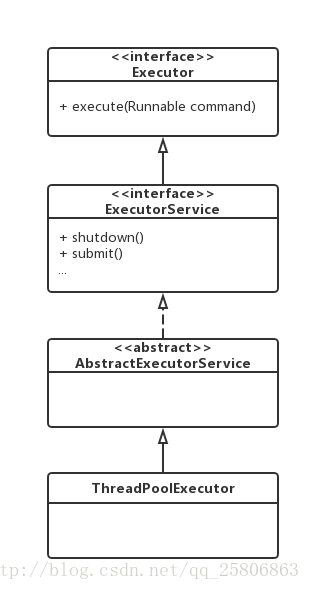Java多线程-线程池ThreadPoolExecutor构造方法和规则
2018-02-27 10:48
393 查看
为什么用线程池
博客地址 http://blog.csdn.net/qq_25806863
原文地址 http://blog.csdn.net/qq_25806863/article/details/71126867
有时候,系统需要处理非常多的执行时间很短的请求,如果每一个请求都开启一个新线程的话,系统就要不断的进行线程的创建和销毁,有时花在创建和销毁线程上的时间会比线程真正执行的时间还长。而且当线程数量太多时,系统不一定能受得了。
使用线程池主要为了解决一下几个问题:
通过重用线程池中的线程,来减少每个线程创建和销毁的性能开销。
对线程进行一些维护和管理,比如定时开始,周期执行,并发数控制等等。
Executor
Executor是一个接口,跟线程池有关的基本都要跟他打交道。下面是常用的ThreadPoolExecutor的关系。

Executor接口很简单,只有一个execute方法。
ExecutorService是Executor的子接口,增加了一些常用的对线程的控制方法,之后使用线程池主要也是使用这些方法。
AbstractExecutorService是一个抽象类。ThreadPoolExecutor就是实现了这个类。
ThreadPoolExecutor
构造方法
ThreadPoolExecutor是线程池的真正实现,他通过构造方法的一系列参数,来构成不同配置的线程池。常用的构造方法有下面四个:
这里写图片描述
构造方法参数说明
corePoolSize
核心线程数,默认情况下核心线程会一直存活,即使处于闲置状态也不会受存keepAliveTime限制。除非将allowCoreThreadTimeOut设置为true。
maximumPoolSize
线程池所能容纳的最大线程数。超过这个数的线程将被阻塞。当任务队列为没有设置大小的LinkedBlockingDeque时,这个值无效。
keepAliveTime
非核心线程的闲置超时时间,超过这个时间就会被回收。
unit
指定keepAliveTime的单位,如TimeUnit.SECONDS。当将allowCoreThreadTimeOut设置为true时对corePoolSize生效。
workQueue
线程池中的任务队列.
常用的有三种队列,SynchronousQueue,LinkedBlockingDeque,ArrayBlockingQueue。
threadFactory
线程工厂,提供创建新线程的功能。ThreadFactory是一个接口,只有一个方法
通过线程工厂可以对线程的一些属性进行定制。
默认的工厂:
当线程池中的资源已经全部使用,添加新线程被拒绝时,会调用RejectedExecutionHandler的rejectedExecution方法。
线程池规则
线程池的线程执行规则跟任务队列有很大的关系。
下面都假设任务队列没有大小限制:
如果线程数量<=核心线程数量,那么直接启动一个核心线程来执行任务,不会放入队列中。
如果线程数量>核心线程数,但<=最大线程数,并且任务队列是LinkedBlockingDeque的时候,超过核心线程数量的任务会放在任务队列中排队。
如果线程数量>核心线程数,但<=最大线程数,并且任务队列是SynchronousQueue的时候,线程池会创建新线程执行任务,这些任务也不会被放在任务队列中。这些线程属于非核心线程,在任务完成后,闲置时间达到了超时时间就会被清除。
如果线程数量>核心线程数,并且>最大线程数,当任务队列是LinkedBlockingDeque,会将超过核心线程的任务放在任务队列中排队。也就是当任务队列是LinkedBlockingDeque并且没有大小限制时,线程池的最大线程数设置是无效的,他的线程数最多不会超过核心线程数。
如果线程数量>核心线程数,并且>最大线程数,当任务队列是SynchronousQueue的时候,会因为线程池拒绝添加任务而抛出异常。
任务队列大小有限时
当LinkedBlockingDeque塞满时,新增的任务会直接创建新线程来执行,当创建的线程数量超过最大线程数量时会抛异常。
SynchronousQueue没有数量限制。因为他根本不保持这些任务,而是直接交给线程池去执行。当任务数量超过最大线程数时会直接抛异常。
规则验证
前提
所有的任务都是下面这样的,睡眠两秒后打印一行日志:
所有验证过程都是下面这样,先执行三个,再执行三个,8秒后,各看一次信息
验证1
核心线程数为6,最大线程数为10。超时时间为5秒
可以看到每个任务都是是直接启动一个核心线程来执行任务,一共创建了6个线程,不会放入队列中。8秒后线程池还是6个线程,核心线程默认情况下不会被回收,不收超时时间限制。
验证2
核心线程数为3,最大线程数为6。超时时间为5秒,队列是LinkedBlockingDeque
当任务数超过核心线程数时,会将超出的任务放在队列中,只会创建3个线程重复利用。
验证3
核心线程数为3,最大线程数为6。超时时间为5秒,队列是SynchronousQueue
当队列是SynchronousQueue时,超出核心线程的任务会创建新的线程来执行,看到一共有6个线程。但是这些线程是费核心线程,收超时时间限制,在任务完成后限制超过5秒就会被回收。所以最后看到线程池还是只有三个线程。
验证4
核心线程数是3,最大线程数是4,队列是LinkedBlockingDeque
LinkedBlockingDeque根本不受最大线程数影响。
但是当LinkedBlockingDeque有大小限制时就会受最大线程数影响了
4.1 比如下面,将队列大小设置为2.
首先为三个任务开启了三个核心线程1,2,3,然后第四个任务和第五个任务加入到队列中,第六个任务因为队列满了,就直接创建一个新线程4,这是一共有四个线程,没有超过最大线程数。8秒后,非核心线程收超时时间影响回收了,因此线程池只剩3个线程了。
4.2 将队列大小设置为1
直接出错在第6个execute方法上。因为核心线程是3个,当加入第四个任务的时候,就把第四个放在队列中。加入第五个任务时,因为队列满了,就创建新线程执行,创建了线程4。当加入第六个线程时,也会尝试创建线程,但是因为已经达到了线程池最大线程数,所以直接抛异常了。
验证5
核心线程数是3 ,最大线程数是4,队列是SynchronousQueue
这次在添加第五个任务时就报错了,因为SynchronousQueue各奔不保存任务,收到一个任务就去创建新线程。所以第五个就会抛异常了。
博客地址 http://blog.csdn.net/qq_25806863
原文地址 http://blog.csdn.net/qq_25806863/article/details/71126867
有时候,系统需要处理非常多的执行时间很短的请求,如果每一个请求都开启一个新线程的话,系统就要不断的进行线程的创建和销毁,有时花在创建和销毁线程上的时间会比线程真正执行的时间还长。而且当线程数量太多时,系统不一定能受得了。
使用线程池主要为了解决一下几个问题:
通过重用线程池中的线程,来减少每个线程创建和销毁的性能开销。
对线程进行一些维护和管理,比如定时开始,周期执行,并发数控制等等。
Executor
Executor是一个接口,跟线程池有关的基本都要跟他打交道。下面是常用的ThreadPoolExecutor的关系。

Executor接口很简单,只有一个execute方法。
ExecutorService是Executor的子接口,增加了一些常用的对线程的控制方法,之后使用线程池主要也是使用这些方法。
AbstractExecutorService是一个抽象类。ThreadPoolExecutor就是实现了这个类。
ThreadPoolExecutor
构造方法
ThreadPoolExecutor是线程池的真正实现,他通过构造方法的一系列参数,来构成不同配置的线程池。常用的构造方法有下面四个:
这里写图片描述
ThreadPoolExecutor(int corePoolSize, int maximumPoolSize, long keepAliveTime, TimeUnit unit, BlockingQueue<Runnable> workQueue)
ThreadPoolExecutor(int corePoolSize, int maximumPoolSize, long keepAliveTime, TimeUnit unit, BlockingQueue<Runnable> workQueue, ThreadFactory threadFactory)
ThreadPoolExecutor(int corePoolSize, int maximumPoolSize, long keepAliveTime, TimeUnit unit, BlockingQueue<Runnable> workQueue, RejectedExecutionHandler handler)
ThreadPoolExecutor(int corePoolSize, int maximumPoolSize, long keepAliveTime, TimeUnit unit, BlockingQueue<Runnable> workQueue, ThreadFactory threadFactory, RejectedExecutionHandler handler)
构造方法参数说明
corePoolSize
核心线程数,默认情况下核心线程会一直存活,即使处于闲置状态也不会受存keepAliveTime限制。除非将allowCoreThreadTimeOut设置为true。
maximumPoolSize
线程池所能容纳的最大线程数。超过这个数的线程将被阻塞。当任务队列为没有设置大小的LinkedBlockingDeque时,这个值无效。
keepAliveTime
非核心线程的闲置超时时间,超过这个时间就会被回收。
unit
指定keepAliveTime的单位,如TimeUnit.SECONDS。当将allowCoreThreadTimeOut设置为true时对corePoolSize生效。
workQueue
线程池中的任务队列.
常用的有三种队列,SynchronousQueue,LinkedBlockingDeque,ArrayBlockingQueue。
threadFactory
线程工厂,提供创建新线程的功能。ThreadFactory是一个接口,只有一个方法
public interface ThreadFactory {
Thread newThread(Runnable r);
}通过线程工厂可以对线程的一些属性进行定制。
默认的工厂:
static class DefaultThreadFactory implements ThreadFactory {
private static final AtomicInteger poolNumber = new AtomicInteger(1);
private final ThreadGroup group;
private final AtomicInteger threadNumber = new AtomicInteger(1);
private final String namePrefix;
DefaultThreadFactory() {
SecurityManager var1 = System.getSecurityManager();
this.group = var1 != null?var1.getThreadGroup():Thread.currentThread().getThreadGroup();
this.namePrefix = "pool-" + poolNumber.getAndIncrement() + "-thread-";
}
public Thread newThread(Runnable var1) {
Thread var2 = new Thread(this.group, var1, this.namePrefix + this.threadNumber.getAndIncrement(), 0L);
if(var2.isDaemon()) {
var2.setDaemon(false);
}
if(var2.getPriority() != 5) {
var2.setPriority(5);
}
return var2;
}
}**RejectedExecutionHandler**
RejectedExecutionHandler也是一个接口,只有一个方法
public interface RejectedExecutionHandler {
void rejectedExecution(Runnable var1, ThreadPoolExecutor var2);
}当线程池中的资源已经全部使用,添加新线程被拒绝时,会调用RejectedExecutionHandler的rejectedExecution方法。
线程池规则
线程池的线程执行规则跟任务队列有很大的关系。
下面都假设任务队列没有大小限制:
如果线程数量<=核心线程数量,那么直接启动一个核心线程来执行任务,不会放入队列中。
如果线程数量>核心线程数,但<=最大线程数,并且任务队列是LinkedBlockingDeque的时候,超过核心线程数量的任务会放在任务队列中排队。
如果线程数量>核心线程数,但<=最大线程数,并且任务队列是SynchronousQueue的时候,线程池会创建新线程执行任务,这些任务也不会被放在任务队列中。这些线程属于非核心线程,在任务完成后,闲置时间达到了超时时间就会被清除。
如果线程数量>核心线程数,并且>最大线程数,当任务队列是LinkedBlockingDeque,会将超过核心线程的任务放在任务队列中排队。也就是当任务队列是LinkedBlockingDeque并且没有大小限制时,线程池的最大线程数设置是无效的,他的线程数最多不会超过核心线程数。
如果线程数量>核心线程数,并且>最大线程数,当任务队列是SynchronousQueue的时候,会因为线程池拒绝添加任务而抛出异常。
任务队列大小有限时
当LinkedBlockingDeque塞满时,新增的任务会直接创建新线程来执行,当创建的线程数量超过最大线程数量时会抛异常。
SynchronousQueue没有数量限制。因为他根本不保持这些任务,而是直接交给线程池去执行。当任务数量超过最大线程数时会直接抛异常。
规则验证
前提
所有的任务都是下面这样的,睡眠两秒后打印一行日志:
Runnable myRunnable = new Runnable() {
@Override
public void run() {
try {
Thread.sleep(2000);
System.out.println(Thread.currentThread().getName() + " run");
} catch (InterruptedException e) {
e.printStackTrace();
}
}
};所有验证过程都是下面这样,先执行三个,再执行三个,8秒后,各看一次信息
executor.execute(myRunnable);
executor.execute(myRunnable);
executor.execute(myRunnable);
System.out.println("---先开三个---");
System.out.println("核心线程数" + executor.getCorePoolSize());
System.out.println("线程池数" + executor.getPoolSize());
System.out.println("队列任务数" + executor.getQueue().size());
executor.execute(myRunnable);
executor.execute(myRunnable);
executor.execute(myRunnable);
System.out.println("---再开三个---");
System.out.println("核心线程数" + executor.getCorePoolSize());
System.out.println("线程池数" + executor.getPoolSize());
System.out.println("队列任务数" + executor.getQueue().size());
Thread.sleep(8000);
System.out.println("----8秒之后----");
System.out.println("核心线程数" + executor.getCorePoolSize());
System.out.println("线程池数" + executor.getPoolSize());
System.out.println("队列任务数" + executor.getQueue().size());验证1
核心线程数为6,最大线程数为10。超时时间为5秒
ThreadPoolExecutor executor = new ThreadPoolExecutor(6, 10, 5, TimeUnit.SECONDS, new SynchronousQueue<Runnable>());
---先开三个--- 核心线程数6 线程池线程数3 队列任务数0 ---再开三个--- 核心线程数6 线程池线程数6 队列任务数0 pool-1-thread-1 run pool-1-thread-6 run pool-1-thread-5 run pool-1-thread-3 run pool-1-thread-4 run pool-1-thread-2 run ----8秒之后---- 核心线程数6 线程池线程数6 队列任务数0
可以看到每个任务都是是直接启动一个核心线程来执行任务,一共创建了6个线程,不会放入队列中。8秒后线程池还是6个线程,核心线程默认情况下不会被回收,不收超时时间限制。
验证2
核心线程数为3,最大线程数为6。超时时间为5秒,队列是LinkedBlockingDeque
ThreadPoolExecutor executor = new ThreadPoolExecutor(3, 6, 5, TimeUnit.SECONDS, new LinkedBlockingDeque<Runnable>());
---先开三个--- 核心线程数3 线程池线程数3 队列任务数0 ---再开三个--- 核心线程数3 线程池线程数3 队列任务数3 pool-1-thread-3 run pool-1-thread-1 run pool-1-thread-2 run pool-1-thread-3 run pool-1-thread-1 run pool-1-thread-2 run ----8秒之后---- 核心线程数3 线程池线程数3 队列任务数0
当任务数超过核心线程数时,会将超出的任务放在队列中,只会创建3个线程重复利用。
验证3
核心线程数为3,最大线程数为6。超时时间为5秒,队列是SynchronousQueue
ThreadPoolExecutor executor = new ThreadPoolExecutor(3, 6, 5, TimeUnit.SECONDS, new SynchronousQueue<Runnable>());
---先开三个--- 核心线程数3 线程池线程数3 队列任务数0 ---再开三个--- 核心线程数3 线程池线程数6 队列任务数0 pool-1-thread-2 run pool-1-thread-3 run pool-1-thread-6 run pool-1-thread-4 run pool-1-thread-5 run pool-1-thread-1 run ----8秒之后---- 核心线程数3 线程池线程数3 队列任务数0
当队列是SynchronousQueue时,超出核心线程的任务会创建新的线程来执行,看到一共有6个线程。但是这些线程是费核心线程,收超时时间限制,在任务完成后限制超过5秒就会被回收。所以最后看到线程池还是只有三个线程。
验证4
核心线程数是3,最大线程数是4,队列是LinkedBlockingDeque
ThreadPoolExecutor executor = new ThreadPoolExecutor(3, 4, 5, TimeUnit.SECONDS, new LinkedBlockingDeque<Runnable>());
---先开三个--- 核心线程数3 线程池线程数3 队列任务数0 ---再开三个--- 核心线程数3 线程池线程数3 队列任务数3 pool-1-thread-3 run pool-1-thread-1 run pool-1-thread-2 run pool-1-thread-3 run pool-1-thread-1 run pool-1-thread-2 run ----8秒之后---- 核心线程数3 线程池线程数3 队列任务数0
LinkedBlockingDeque根本不受最大线程数影响。
但是当LinkedBlockingDeque有大小限制时就会受最大线程数影响了
4.1 比如下面,将队列大小设置为2.
ThreadPoolExecutor executor = new ThreadPoolExecutor(3, 4, 5, TimeUnit.SECONDS, new LinkedBlockingDeque<Runnable>(2));
---先开三个--- 核心线程数3 线程池线程数3 队列任务数0 ---再开三个--- 核心线程数3 线程池线程数4 队列任务数2 pool-1-thread-2 run pool-1-thread-1 run pool-1-thread-4 run pool-1-thread-3 run pool-1-thread-1 run pool-1-thread-2 run ----8秒之后---- 核心线程数3 线程池线程数3 队列任务数0
首先为三个任务开启了三个核心线程1,2,3,然后第四个任务和第五个任务加入到队列中,第六个任务因为队列满了,就直接创建一个新线程4,这是一共有四个线程,没有超过最大线程数。8秒后,非核心线程收超时时间影响回收了,因此线程池只剩3个线程了。
4.2 将队列大小设置为1
ThreadPoolExecutor executor = new ThreadPoolExecutor(3, 4, 5, TimeUnit.SECONDS, new LinkedBlockingDeque<Runnable>(1));
Exception in thread "main" java.util.concurrent.RejectedExecutionException: Task com.sunlinlin.threaddemo.Main$1@677327b6 rejected from java.util.concurrent.ThreadPoolExecutor@14ae5a5[Running, pool size = 4, active threads = 4, queued tasks = 1, completed tasks = 0] at java.util.concurrent.ThreadPoolExecutor$AbortPolicy.rejectedExecution(ThreadPoolExecutor.java:2047) at java.util.concurrent.ThreadPoolExecutor.reject(ThreadPoolExecutor.java:823) at java.util.concurrent.ThreadPoolExecutor.execute(ThreadPoolExecutor.java:1369) at com.sunlinlin.threaddemo.Main.main(Main.java:35) at sun.reflect.NativeMethodAccessorImpl.invoke0(Native Method) at sun.reflect.NativeMethodAccessorImpl.invoke(NativeMethodAccessorImpl.java:62) at sun.reflect.DelegatingMethodAccessorImpl.invoke(DelegatingMethodAccessorImpl.java:43) at java.lang.reflect.Method.invoke(Method.java:498) at com.intellij.rt.execution.application.AppMain.main(AppMain.java:147) ---先开三个--- 核心线程数3 线程池线程数3 队列任务数0 pool-1-thread-1 run pool-1-thread-2 run pool-1-thread-3 run pool-1-thread-4 run pool-1-thread-1 run
直接出错在第6个execute方法上。因为核心线程是3个,当加入第四个任务的时候,就把第四个放在队列中。加入第五个任务时,因为队列满了,就创建新线程执行,创建了线程4。当加入第六个线程时,也会尝试创建线程,但是因为已经达到了线程池最大线程数,所以直接抛异常了。
验证5
核心线程数是3 ,最大线程数是4,队列是SynchronousQueue
ThreadPoolExecutor executor = new ThreadPoolExecutor(3, 4, 5, TimeUnit.SECONDS, new SynchronousQueue<Runnable>());
Exception in thread "main" java.util.concurrent.RejectedExecutionException: Task com.sunlinlin.threaddemo.Main$1@14ae5a5 rejected from java.util.concurrent.ThreadPoolExecutor@7f31245a[Running, pool size = 4, active threads = 4, queued tasks = 0, completed tasks = 0] at java.util.concurrent.ThreadPoolExecutor$AbortPolicy.rejectedExecution(ThreadPoolExecutor.java:2047) at java.util.concurrent.ThreadPoolExecutor.reject(ThreadPoolExecutor.java:823) at java.util.concurrent.ThreadPoolExecutor.execute(ThreadPoolExecutor.java:1369) at com.sunlinlin.threaddemo.Main.main(Main.java:34) at sun.reflect.NativeMethodAccessorImpl.invoke0(Native Method) at sun.reflect.NativeMethodAccessorImpl.invoke(NativeMethodAccessorImpl.java:62) at sun.reflect.DelegatingMethodAccessorImpl.invoke(DelegatingMethodAccessorImpl.java:43) at java.lang.reflect.Method.invoke(Method.java:498) at com.intellij.rt.execution.application.AppMain.main(AppMain.java:147) ---先开三个--- 核心线程数3 线程池线程数3 队列任务数0 pool-1-thread-2 run pool-1-thread-3 run pool-1-thread-4 run pool-1-thread-1 run
这次在添加第五个任务时就报错了,因为SynchronousQueue各奔不保存任务,收到一个任务就去创建新线程。所以第五个就会抛异常了。
相关文章推荐
- Java多线程-线程池ThreadPoolExecutor构造方法和规则
- Java多线程之Thread、Runnable、Callable及线程池
- Java 7之多线程线程池 - Callable和Future
- [Java多线程 十]---JUC包下线程池的理解
- 【Java多线程与并发库】8.java5线程并发库之线程池的应用
- 六、JAVA多线程与常见的线程池
- java多线程:线程池的原理及实现
- java多线程线程池的原理与实现
- java多线程系列(六)---线程池原理及其使用
- 黑马程序员-------------多线程中的(线程、线程组、线程池、以及Java的设计模式)概念及方法的总结
- java多线程并发及线程池
- Java 多线程:线程池
- Java多线程简析——Synchronized(同步锁)、Lock以及线程池
- 我之见--java 多线程 线程池ThreadPoolExecutor源码分析
- 【java多线程】java的线程池分析
- Java Thread 多线程 线程池
- java多线程和线程池
- java中this语句来调用其他构造方法的规则
- JAVA多线程:线程池
- Java的多线程与线程池的使用
